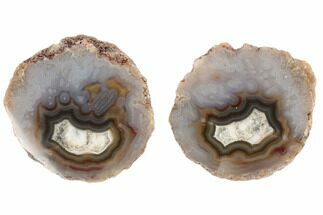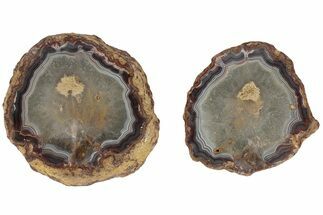This Specimen has been sold.
Unique, 3.9" Polished Banded Agate Nodule Half - Morocco
This is a unique polished agate nodule half that was collected from (likely Agouim) Morocco. It features chalcedony that formed after what appears to be scalenohedral calcite crystals. The outlines of these crystals remained intact, along with what appears to be a chalcedony replaced line that branches off the wall of the pre-existing crystal, indicating there was rhombohedral cleavage.
One side of this specimen has been cut flat and polished to a glossy finish, while the other side and outer edge have been left rough. This agate specimen comes with an acrylic display stand.
One side of this specimen has been cut flat and polished to a glossy finish, while the other side and outer edge have been left rough. This agate specimen comes with an acrylic display stand.
The Wegeler effect, also known as the shadow effect or parallax effect, is a three-dimensional oddity in which rotating a banded agate creates the illusion that those banding lines move. One line will move with the source of light while the other moves with your point of view. This occurs in agate that has tightly packed, alternating bright opaque bands and transparent bands.
Banded agate nodules from Kerrouchen (also spelled Karouchen or Kerrouchene) are known for their intense red, pink, white, yellow, orange and brown agate hues. They formed as nodules from silica and iron-rich fluids within Triassic-age basaltic rock. These nodules can reach upwards of 12 inches wide and can be collected from the basalt itself. More commonly, they're collected from apple farms in the valleys where farming processes expose these nodules that erode from the basalt. Both nodular and vein/seam agates come from this region.
Agate is a variety of microcrystalline quartz (chalcedony) that displays translucence and, in some cases, banding. Agate primarily forms when silica-rich fluids fill pockets within rocks and/or fossils, depositing the silica along the walls of the rock. This process can result in banding patterns, as the compositions and impurities of these depositing fluids change over time. These banding patterns can either form as flat layers, creating linear patterns known as waterline agate, or as rounded layers, forming more common ring-like patterns. These patterns depend on the surfaces available for deposition.
Agate is a variety of microcrystalline quartz (chalcedony) that displays translucence and, in some cases, banding. Agate primarily forms when silica-rich fluids fill pockets within rocks and/or fossils, depositing the silica along the walls of the rock. This process can result in banding patterns, as the compositions and impurities of these depositing fluids change over time. These banding patterns can either form as flat layers, creating linear patterns known as waterline agate, or as rounded layers, forming more common ring-like patterns. These patterns depend on the surfaces available for deposition.
SPECIES
Chalcedony var. Agate
LOCATION
Morocco
SIZE
3.9 x 2.7", up to 1.6" thick
CATEGORY
SUB CATEGORY
ITEM
#187228
 Reviews
Reviews













